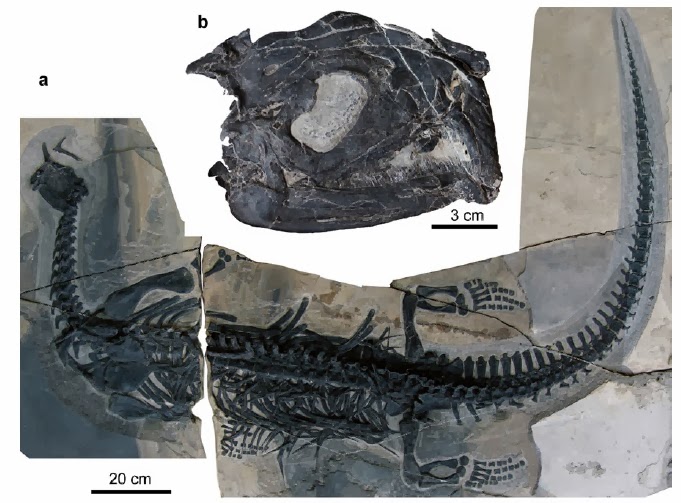 |
| Atopodentatus unicus
illustration: Julius Csotonyi | csotonyi.com
|
Abstract
The Luoping fauna (Anisian, Middle Triassic) is probably the oldest of Triassic faunas in Guizhou–Yunnan area, China. The reptilian assemblage is comprised of ichthyosaurs, a number of sauropterygians (pachypleurosaur-like forms), saurosphargids, protorosaurs, and archosauriforms. Here, we report on a peculiar reptile, newly found in this fauna. Its dentition is fence or comb-like and bears more than 175 pleurodont teeth in each ramus of the upper and lower jaws, tooth crown is needle-like distally and blade-shaped proximally; its rostrum strongly bends downward and the anterior end of its mandible expands both dorsally and ventrally to form a shovel-headed structure; and its ungual phalanges are hoof-shaped. The specializations of the jaws and dentition indicate that the reptile may have been adapted to a way of bottom-filter feeding in water. It is obvious that such delicate teeth are not strong enough to catch prey, but were probably used as a barrier to filter microorganisms or benthic invertebrates such as sea worms. These were collected by the specialized jaws, which may have functioned as a shovel or pushdozer (the mandible) and a grasper or scratcher (the rostrum). Our preliminary analysis suggests that the new reptile might be more closely related to the Sauropterygia than to other marine reptiles.
Keywords: Diapsida, Bottom-filter feeding, Middle Triassic, Yunnan, China
Cheng, L.; Chen, X. H.; Shang, Q. H.; Wu, X. C. 2014. A New Marine Reptile from the Triassic of China, with a highly specialized Feeding Adaptation. Naturwissenschaften. doi: dx.doi.org/10.1007/s00114-014-1148-4

